Franconian Wine & Wine Region
The special appeal of the Maindreieck (the triangular stream course here) makes the vines and therefore the famous Franconian wine in the valley mature very well. In terms of soils and dimension of the wnie-growing district the Frankenwein (german labeling for this local wine) may not keep pace with its big competitors. But in fact, the Franconian wine simply does not have to.
Franconian Wine dominates the image
Although Ochsenfurt is also regarded as a beer town and not just as a wine town, the wine characterizes the city to a certain extent.
For sure, visitors will collect three impressions of the town: the old town itself with its medieval character, the sugar factory, which belongs to Ochsenfurt just as, well, the vineyards do.
The decisive weight of the vineyards is still moderate in Ochsenfurt. Although the ascending rows of grapevines on the northern slope (and thus south, or rather, south-west, exposed) are unmistakable. However, this is no comparison to other cities and localities in the immediate vicinity. The little venue Frickenhausen, for example, located roughly opposite the sugar factory on the other side of the river, „drowns“ almost into wine growing.
The reasons for the somewhat more moderate dominance of wine cultivation in Ochsenfurt are manifold. Ochsenfurt is one of the oldest cities in the region. It came relatively early to certain wealth. This location factor favored, among other things, the early settlement of the slopes. Those then quickly became residential areas and could therefore not be cultivated for wine anymore.
In addition, the old town is located on the south side of the river, the coveted location for wine-growing are the northern slopes where the vines get the best orientation towards the sun (south and south-west).
And yet the Franconian wine is extremely present in Ochsenfurt as everywhere in the region along the river. With wine culture you are growing up here. Hardly any family misses some kind of relationship to one of the wineries in the surrounding area. The wine festivals are an integral part of the cultural calendar of the city and the region. Also in Ochsenfurt one of those takes place of course. At the end of July in the – how could it be otherwise – historical moat of of the town.
Location Factors: River, Climate & Soils
The special microclimate and the geological uniqueness that Keuper, Lower Trias and, in particular, Muschelkalk clash here, experts consider a decisive success factor of the Franconian wine.
Without the soil, and without the river, the Main, there would be not only no Frankenwein here. Without the river Main no region of Mainfranken of course. For hundreds of years, the Main has shaped the appearance and the life in the region.
But how could a river shape the landscape and the culture so extraordinarily strong here? The answer is that, apart from the location factors climate and soil, there is this special.. well… feature of the river. The Maindreieck. Due to the marked bend of the river which forms a triangle here you get those certain hillsides, which, so to speak, provide more direct sunlight than elsewhere.
The climate in Mainfranken and also in Ochsenfurt is extremely advantageous and easy to describe. The region offers a lot of sun on the one hand, and only few rainfall on the other. When clouds have crossed the three Middle Mountains in the North, East and West, most of the water has already fallen from the sky. This, of course, does not mean that extreme weather conditions with heavy rain, hail or even winter storms do not occur here.
Wine as an Economic Factor
The economic importance of the Frankenwein (Franconian wine) for the region since many hundred years can not be shown clearly enough.
The beer (Ochsenfurt has two private breweries) followed the wine in the late 19th century. Favored by a regular crisis in the cultivation of wine occurring at the beginning of the 20th century. This was triggered by a particularly aggressive form of phylloxera, causing economic trouble for a lot of towns here. But through various measures such as the establishment of new grape varieties and a reform of the vineyards, the decline of Franconian wine culture could be prevented.
Today, Mainfranken contributes largely to the fact that Bavaria is the third largest wine-growing area in Germany. The Franconian wine is, however, very popular and can be counted with fugue and right to one of those wiht the best quality and reputation in the world.
